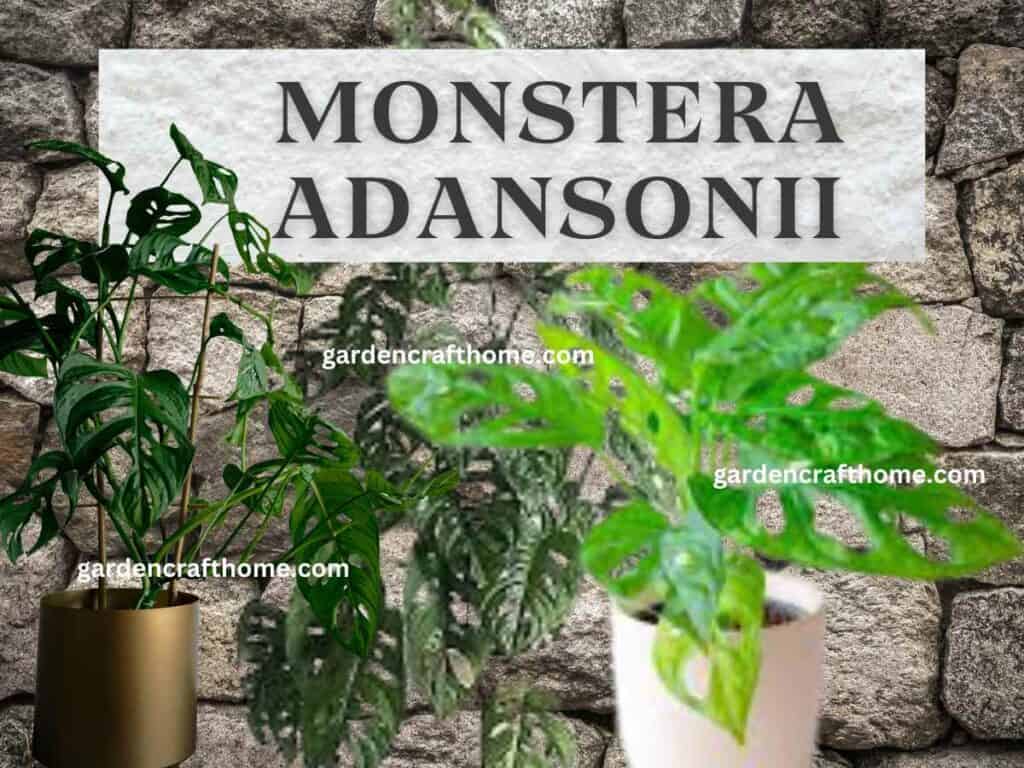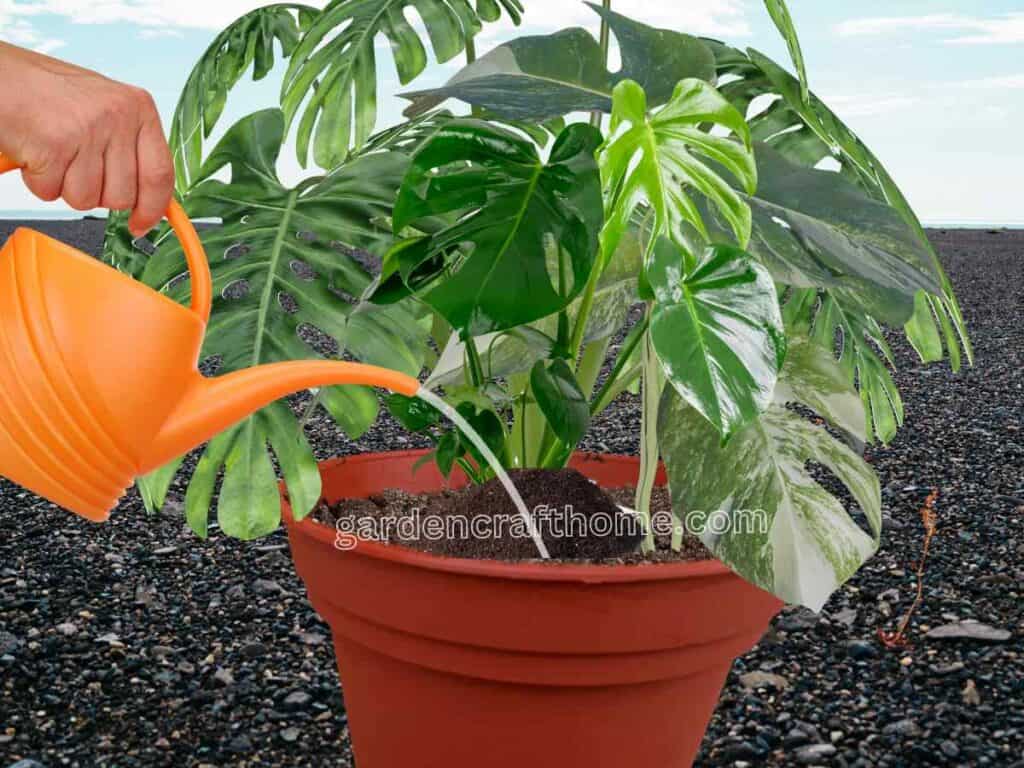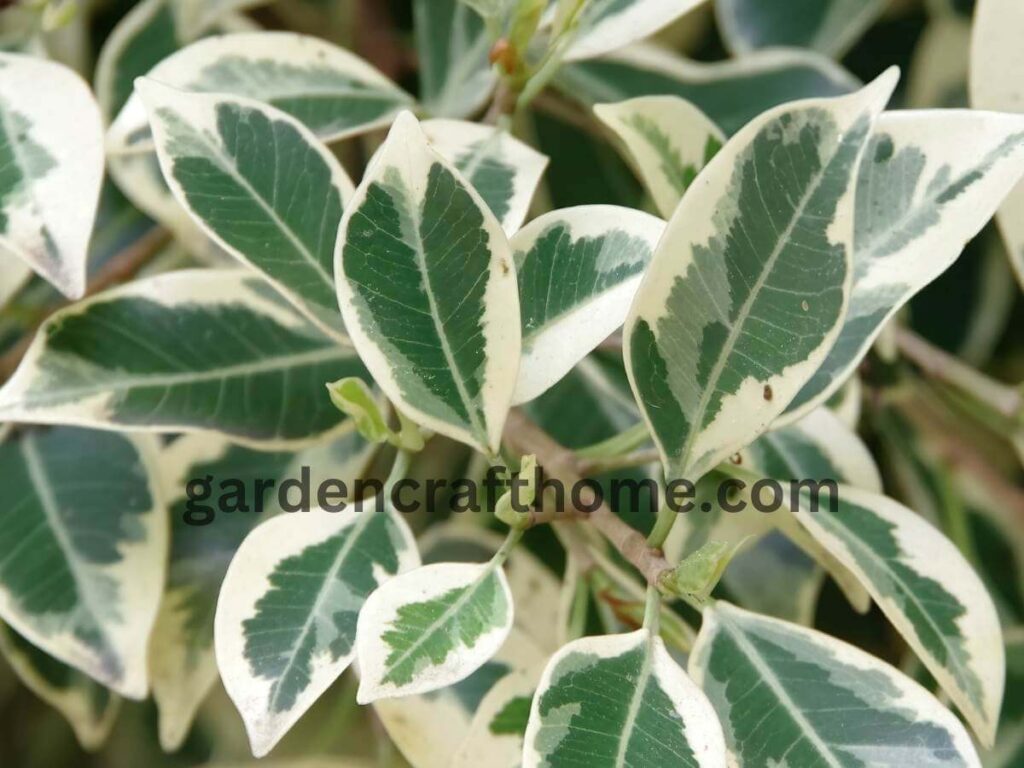Monstera adansonii care is when you give them the right fertilizer, water quantity, sunlight, soil, maintenance, etc.
Did you know Monstera Adansonii has won the hearts of experienced and novice plant owners because Monstera Adansonii care is simple? I will give you the lowest explanation.
If you’re wondering how to help your Monstera Adansonii grow faster, taller, and healthier, you’re in the right place.
In this article, I will give you the tips and tricks to create the best growing conditions for your Monstera adansonii, Starting From watering to lighting, temperature fertilization, etc.
If you are interested in knowing the 21 types of Monstera, click here. [Link]
Quick View Of Monstera Adansonii
Monstera Adansonii Common Name;
- Anona Pineapple
- Ventanilla
- Cat’s Lung Plant
- Swiss Cheese Plant
- Monkey Monstera
Monstera Adansonii Scientific Name:
- Monstera Adansonii
- Monstera friedrichsthalii
Family;
- Araceae
Origin;
- Deep jungle of Central America
Size:
- Indoors, it can grow to about 1.8m in height and a spread of 2m (when mature and with enough light)
Light:
- Monstera Adansonii needs Bright, indirect sunlight for at least six hours daily. Provide indirect sunlight through a curtained window.
- It can be placed hanging or on the ground in a pot about one meter from a window without curtains.
Click here to learn how to make a hanging planter for Monstera.
Irrigation:
- Monstera Adansonii needs to be watered when the top 2 to 5 cm of soil is dry.
Humidity
- Monstera Adansonii thrives in high humidity, between 50 and 60%. If more humidity is required, a humidifier can be utilized.
Substratum:
- Monstera Adansonii must be Well drained, aerated, and rich in organic matter, slightly acidic to neutral, with a pH of 5.5 to 7. I use 1/2 potting soil with 1/2 coconut fiber and a 2 cm worm casting layer.
Temperature:
- The ideal temperature for Monstera Adansonii ranges between 15-27°C. The absolute minimum temperature it can tolerate is 10°C.
Multiplication method:
- The method of propagating Monstera Adansonii is By stem cuttings in soil or water air layering, which are more reliable. Cut a section of the mother plant with a couple of leaves, approximately 1 cm below a node),
Also, click here to learn how to propagate a Monstera by seed, and you will learn how to select a good seed and harvest your own if you have one. [Link]
Also, click here to learn how to propagate Monstera by stem cuttings in water and soil or by air layering, which are more reliable. [Link]
Diseases and pests:
- The diseases that fight Monstera Adansonii are root rot, Yellow, brown, or curled leaves.
Click here to learn how to cure your Monstera from yellowing leaf.
In summary, I will discuss all the above items immediately after this section, so continue reading and enjoy as you understand what I’m trying to discuss.
How Often To Water Monstera Adansonii
Water a plant once a week or every two weeks in winter, but this can depend on factors like the environment, pot size, and humidity.
To remain safe, Here is a general guideline to water Monstera Adansonii water when the soil’s top inch (2.5 cm) feels dry.
Suppose you habitually pour a week’s glass of water into your plant’s pot. In that case, there are much better ways to water your Monstera Adansonii.
Remember, Monstera Adansonii care is essential.
Improper watering during Monstera Adansonii care can cause a lot of damage to a healthy plant, so watering is always the first thing I advise you to consider during Monstera Adansonii care.
Several factors, such as hibernation, indoor temperature, soil type, and light exposure, can influence a Monster’s water need.
And with the possible risk of root rot that can result from overwatering, it’s best to be smart about your watering strategies.
Generally, it is best to water your plant only when the top 2 to 5 cm of soil is dry.
You can determine this by inserting a finger into the soil of the Monstera and feeling for moisture in the soil.
If you sense residual moisture, wait until the soil is dry before watering.
If you don’t want to check by feel, consider purchasing a moisture meter[ aff pro] to tell you when to add more water.
Using any of these techniques, you may notice that the frequency with which you water your Swiss cheese plant varies – that means you’re doing it right!
When you water your plant, use enough water to come out of the holes in the bottom of the pot.
This may seem like a lot of water, but it is essential to hydrate the soil entirely.
Click here to learn how to water a Monstera plant properly. [Link]
The Humidity Necessary To Grow A Monstera Adansonii
Humidity is necessary for Monstera Adansonii care because it is native to the tropical forests of Mexico and Panama and needs higher environmental humidity to grow and develop healthily.
A 50% – 60% humidity is optimal for Monstera Adansonii care and helps protect its delicate leaves and aerial roots.
It is important to remember that signs of dehydration and shock in Monstera Adansonii can be confused with a need for water, leading to excessive watering and root rot.
Therefore, it is essential to determine if the plant needs more humidity or simply more water.
Knowing if you need to increase the humidity in your Monstera plant is helpful to know the humidity level in your home.
A hygrometer is an inexpensive and easy-to-use device that will allow you to determine the humidity in your home.
Once you know your home’s humidity level, you can increase it in the areas where your plant is located.
Some effective strategies to increase the humidity in your Monstera Adansonii’s environment are below: 👇
· Locate the plant away from heat sources, such as radiators and air conditioning ducts.
· Place the plant in the kitchen or bathroom since these spaces usually have a more humid environment (remember that it needs light)
· Place containers with water in different places in the house.
· Using humidifiers is also an excellent strategy to increase humidity in the environment. These devices can be portable or stationary and help disperse moisture into the air. However, it is essential to note that humidifiers also need regular maintenance and cleaning to prevent the growth of bacteria and fungi.
What Is The Ideal Soil For Monstera Adansonii Care?
The ideal soil for Monstera adansonii should be well-drained, aerated, and rich in organic matter.
Monstera Adansonii soil should be slightly acidic to neutral, with a pH preferably of 5.5 to 7.
Avoiding heavy or compacted soil mixes, water-absorbing gels, or (moisture-controlled) beds is crucial.
The following characteristics should be considered to determine the best soil for Monstera.
A Good Soil Retains Moisture:
Good soil should retain moisture without being soggy. Very wet soils attract pests such as fungus gnats and can cause root rot.
Peat or coco can help retain moisture in the soil. Additionally, bark and compost can also help retain water.
If the soil dries out too quickly, it must be watered frequently, or the plant will end up dehydrated.
A Good Soil Drained Out Water:
Any soil mix for Monstera should be well-drained, allowing water to pass through at a moderate rate without forming puddles.
Heavy, compacted soils do not drain well and can cause root rot or difficulty for plants to absorb nutrients and water.
On the other hand, if the water passes too quickly, the plant will not have enough time to absorb the water.
To improve drainage, perlite, pumice stone, vermiculite, and fine gravel, among others, can be used. The drainage capacity of Monstera depends on the proportion of these components.
Good Soil Should Be Airy Or Well-Ventilated
Monstera Adansonii roots need oxygen to grow and function properly. Therefore, the soil mixture must be aerated.
Heavy, compacted soils prevent air passage and can contribute to root rot.
Perlite, vermiculite, or pumice can be used to aerate the soil. Coarse sand, gravel, or bark chips can also help if you have none.
A Good Soil Is Rich In Organic Matter
Organic matter is essential in Monstera Adansonii’s care because, in nature, Monstera grows on animal droppings.
Monstera grows on decomposing organic matter (leaves, bark, etc.), rich in humus or organic matter.
Ensure your mix contains some organic matter for your potted Monstera.
Compost is a good source of organic matter, such as worm droppings and compost.
This will help improve the microbes’ health, improving the soil structure.
A Soil With PH Slightly Acidic To Neutral
In Monstera Adansonii care, soil pH affects the absorption or availability of nutrients and soil microbes.
A high pH above 7.5 will decrease iron availability and may cause yellowing of Monstera leaves. Similarly, a very low pH can affect the availability of other nutrients and microbes.
My Recommended Soil Mix For Monstera.
Monstera Adansonii grows deep in the rainforest, requiring nutrient-rich, well-drained soil.
My Monstera grows best on a soil mix of peat and compost, with a few extras added to help drainage and aeration.
I start the mix with about 1/2 potting soil. I then add about 1/2 coconut coir, a more sustainable alternative to peat moss.
The coconut fiber also helps retain moisture in the mixture.
To improve aeration and drainage, I add a few bunches of orchid bark and a few handfuls of compost or worm castings. This also adds additional nutrients to the soil mix.
To finish the mixture, I add a 2 cm layer of worm castings, which is rich in nutrients and helps improve soil structure.
Before placing the soil mixture in the pot, I cover the drainage holes with paper to prevent the fresh mixture from escaping.
This soil mix works well for my Monstera Adansonii. Still, every plant is different, so you may need to experiment with different ratios of materials to find the perfect mix for your plant.
The important thing is to make sure the soil mix retains moisture, drains well, and is rich in nutrients.
How Much Sun Does Monstera Adansonii Need?
Sunlight is necessary when caring for Monstera Adansonii because sunlight produces photosynthesis, and lack of photosynthesis can cause yellowing leaves.
Click here to learn how to treat Monstera yellowing leaves.
The light your plant receives is critical to its overall health and reproduction.
Although plants need light to conduct photosynthesis and create energy, this does not mean they need the maximum light possible.
Note: too much light can damage the leaves of your Monstera adansonii.
Monstera adansonii requires at least six hours of bright, indirect sunshine daily. However, each plant is a little different.
It is important to note that the sun’s UV rays can damage the leaves of many plants, especially those that do not receive direct sunlight in nature.
These plants often develop more delicate leaves than the thick and sometimes waxy leaves of plants that grow in direct sun.
It is advisable to provide indirect sunlight through a window with curtains.
Or by placing it about a meter from a window without curtains. To avoid damaging the leaves of your Monstera adansonii,
Window type of filtered sunlight exposure does not produce the same degree of heat or UV exposure, so it is safe for the leaves of delicate plants.
Carefully monitoring the leaves of your Monstera adansonii to determine if it is receiving the proper amount of light is undoubtedly a good idea.
The leaves may get too much direct sunlight if they appear scorched or yellow.
On the other hand, if the leaves look pale or drooping, it may need more sunlight.
With adequate light, Monsteras can snowball. [Link]
Idea Temperature For Monstera Adansonii
Giving your Monstera Adansonii a suitable temperature is like caring for your Monstera Adansonii.
because Monstera Adansonii is native to the rainforests of Mexico and Panama, meaning it
needs warm temperatures year-round.
Monstera temperature can make the difference between success and failure when caring for Monstera Adansonii plants, so it is essential to know the temperature requirements for Monstera plants.
Monstera Adansonii grows best when the room temperature is between 15 and 27 degrees Celsius;
These temperatures best mimic the environment it would grow in in its natural habitat.
If Monstera is kept below 10 degrees Celsius, it will likely not survive.
Additionally, it is essential to keep Monstera away from areas with volatile temperatures.
Areas such as near doors or drafts, as these locations often have temperature fluctuations and can pose a risk to the plant’s health.
Monstera plants grow in warm temperatures; temperatures above 37 degrees Celsius can seriously damage the plant, especially if it is not protected from sun rays and appropriately watered.
The best temperature for your Monstera should not be higher than 32 degrees Celsius or lower than 15 degrees Celsius.
You can take the Monstera outside and let it air out on warm spring, summer, and autumn days.
Ensure the temperature is not lower than 15 degrees Celsius, and there is no sudden drop in temperature while the Monstera is outside.
Suppose you notice the temperature starting to drop. In that case, you should quickly move the Monstera inside to protect it from damage.
Proper Use Of Fertilizers For Monstera Adansonii
It is essential to use appropriate, high-quality fertilizers to maintain the health of Monstera adansonii.
The three most important minerals are nitrogen, phosphorus, and potassium. Still, other minerals in smaller amounts, such as magnesium, calcium, and sulfur, are also essential.
The ratio of these minerals is represented as an NPK ratio on the fertilizer label.
A balanced 20-20-20 liquid fertilizer is recommended for a full-leaf plant like Monstera to achieve healthy, vigorous growth.
During the planting season, which lasts from spring until fall, the plant should be fertilized every two weeks to once a month.
During the fall and winter, when the plant is in a state of hibernation, and its growth has slowed, it should not be fertilized.
Too much fertilizer could damage the plant’s roots.
My Experiment: I Prefer To Use Worm Castings To Fertilize
Using compost to fertilize Monstera Adansonii is a natural option to nourish the plant.
The option closest to its natural habitat would be worm castings, which imitates the decomposition of plant matter in its natural environment and the action of worms and insects that enrich the soil with their excrement.
To use compost, apply it once or twice a year, depending on the condition of the plant, placing a 1-1.5cm layer over the soil and working it in lightly with your fingers before watering.
The worm compost will enrich the soil and nourish the Monstera Adansonii.
Also, read How To Make A Bonsai Tree Grow Bigger
How To Propagate Monstera Adansonii
The multiplication of Monstera adansonii is a simple and accessible process, thanks to its nature as a climbing plant.
It can be done in water or on land and can even be left in water permanently if desired.
In this section, we will explore the multiplication methods of Monstera adansonii and how to make the most of its properties to obtain a healthy and robust plant.
Multiplication By Cuttings In Water
The multiplication of Monstera adansonii by cuttings in water is a simple and effective process.
To begin, you must cut a section of the mother plant with a couple of leaves approximately 1 cm below a node. The nodes are the points where the new roots will emerge.
Removing the lower leaves to leave a few centimeters of bare stem is essential.
Then, place the cutting in a glass of water, ensuring that at least one node is below the surface and that none of the leaves are submerged.

It is essential to place the cutting in a place with bright, diffuse light.
It is necessary to change the water regularly when it becomes cloudy and refill the glass when the level decreases.
Small roots will likely emerge in a week or two, but it may take a few weeks before the cutting can be transferred to the soil.
When the roots are a couple of centimeters long, the cutting can be transferred to its permanent pot.
After the transfer, you can usually water and care for the plant.
Also, read How To Transplant A Bonsai Tree
Multiplication By Cuttings Directly In The Ground
Another method of multiplying Monstera adansonii and other climbing plants is to place the entire cutting on the soil’s surface, with all the nodes facing down, in contact with the soil.
You can also cut the stem into small sections and follow this process instead of leaving it as a complete stem or cutting, ensuring each section has a node.
Sections can be temporarily “pinned” to the floor with pins or paper clips if necessary.
Place the plant in a location with bright, diffuse light, and keep the soil moist but not wet while the roots develop.
You can also place a clear plastic bag over the top to help retain moisture. Removing the bag once a day is essential to allow fresh air to enter.
Over time, the nodes in contact with the soil will also develop roots.
Click here to learn how I successfully propagate my Monstera.[Link]
also, read Are Snake Plants Poisonous To Cats And Dogs?
Common Diseases And Problems Of Monstera
Here, we are going to see the most common problems found with that plant:
Rolled Leaves Of Monstera
Monstera Adansonii curled leaves can have many different causes.
You will need to review the care and environment you provide to see if you can identify where the problem lies.
Then, it should be simple to adapt your care and assist your plant to recover rapidly.
Monstera curled leaves can be caused by:
- Lack of irrigation
- Low air humidity
- Fast dry
- Root problems
- Excessive heat
Yellow leaves of Monstera
It is worrying to see that the leaves of your Monstera adansonii are turning yellow. Sadly, this is a rather generic symptom.

Yellowing of leaves is a standard reaction to a wide range of problems, so you will need to review the care you give your plant carefully.
Any of the following factors can cause yellow Monstera leaves:
- Excess watering
- Inadequate drainage
- Low light
- Bad soil
- Old age
- Nutrients deficiency
- Pests or natural progress.
If you want to know more about the courses and how to cure Monstera yellowing leaf, click here. [Link]
Some yellow leaves below the plant are entirely normal. Allow the plant to reabsorb the nutrients from these leaves before removing them when dry.
also, read Know The 9 Causes And The Solution Of Spider Plant Brown Tips
Monstera Root Rot
When caring for Monstera, avoid root rot because it is a severe problem that can arise in Monstera’s health.
This is because rot can spread quickly and is irreversible. It can travel from the roots, turning your previously beautiful houseplant into a mass.
In general, root rot is caused by excess moisture. Excessive watering, using a pot without a drainage hole, and poorly draining soil can contribute to this problem.
Low light is also a contributing factor, as your plant will not be able to use the water you give it efficiently without enough light.
The symptoms of rotten roots can vary: yellowing, blackening, spots on the leaves, wilting, and curling are all possible effects.
Therefore, if any of these problems arise, reviewing your watering schedule and checking soil moisture levels is always worth examining.
You must remove your Monstera from its pot to check the roots if suspicious.
Unfortunately, your plant is in trouble if the roots appear soft, black/brown, and have a foul odor.
If you find root rot on your Monstera plant, you must assess the damage, remove all affected parts, replant in fresh, suitable soil, and be patient.
Keep your Monstera in a well-lit location with adequate air humidity, and moisten the soil.
Hopefully, the plant will regrow its roots, and the problems will not arise again.
Click here to learn how to Repot a Monstera. [Link]
Monstera Adansonii Care Frequently Asks Questions.
What Is The Best Location For Monstera Adansonii?
Monstera Adansonii prefers a warm, humid environment and bright indirect light.
It is recommended to place it near a window where it can get enough bright indirect light, but at a distance of one to two meters to avoid woody growth.

Light is essential for the development of leaves with characteristic fissures.
When To Support Monstera Adansonii?
The need to support a Monstera Adansonii depends on the desired growth and the interest in it growing that way.
If you want its stems to hang, it is unnecessary to put support to avoid its growth on the ground.
Also, if you want to avoid its growth on other plants, it is necessary to put a vertical stake when the plant gains height.
If you see that it begins to grow inclined, it is a clear sign that it cannot support its weight and is necessary to provide support.
The decision is subjective initially, but the need for vertical support becomes almost urgent as the plant grows and takes up more space.
But this is another unique topic. Click here to learn how to support a Monstera with a stake, [Link]
How Fast Does Monstera Adansonii Grow?
Monstera adansonii can climb up to about 3 meters indoors. It can develop sizes up to 4 meters long as a vine.
This Monstera can grow surprisingly quickly. While many plants can reach heights of 15 to 30 cm a year, Monstera adansonii can grow up to 60 cm in a single season.
How To Make The Monstera Grow Upwards?
To make the Monstera grow upwards, you need to offer it support. A good option is to use a moss stick.
A moss stick provides an organic support, allowing the aerial roots to attach and guide the plant upwards.
It can be fixed with a thread; over time, the plant will get used to using it independently.
Monstera can grow on the wall, which can be challenging to remove without damaging.
Finally, the growth direction of the Monstera can be guided with careful pruning. Click here to learn how to prune Monstera.
Is Monstera Adansonii Toxic To Cats?
If ingested, Monstera Adansonii can be toxic to cats, as it contains calcium oxalate crystals.
This chemical irritates the mouth, throat, and stomach, leading to vomiting and drooling.
Although ingesting large amounts of calcium oxalate crystals can damage the kidneys, this is rare due to immediate irritation.
To know more about Monstera toxicity to cats, click here. [Link]
What Are The Differences Between Monstera Adansonii And Monstera Obliqua?
The leaves of the obliqua are thinner and have wavy edges. In comparison, the leaves of the adansonii are thicker and have straight edges.
Obliqua grows more slowly and is much more expensive than adansonii.
Many sellers mislabel plants as obliqua when they are adansonii, so buying from trusted sellers is essential.
But to get yourself safe, I have already written an entire article dedicated to the difference between monstera adansonii and monstera obliqua.
Click here to read if you are interested. [Link]
Conclusion
Monstera Adansonii Care is straightforward; you only have to provide the required needs and nothing more. You can always come back to this website, gardencrafthome.com
You can care for Monstera Adansonii by providing adequate watering, indirect sunlight, warm humidity, and an excellent environment.
Remember that lousy soil and direct sunlight can lead to yellow leaves.
More articles for Monstera. [Link]





